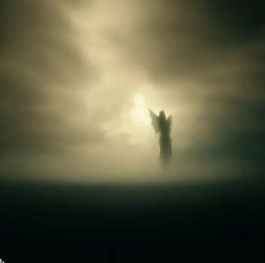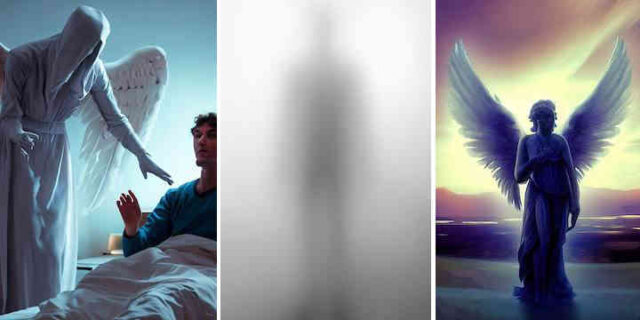Some people say they have seen an angel. Others say an angel, whether seen or not, has helped them. Many more believe in angels – over half people in the US for example.
And it’s not just Christian believers, but believers in other religions as well. Even some atheists believe that have seen or been helped by an angel.
Are these stories true occurrences or just imagination? What’s going on? Does anybody know?
Angel reports
First, let’s see what people claim without making any judgments until we have checked out the evidence. The stories I outline here apparently come from first hand accounts.
People apparently encounter angels in several different ways.
Seeing an angel helping in need
A family lived near a railway, and one day the mother saw her three year old daughter, Lisa, wander off their property and onto the railway track as a train approached. The mother ran from the house screaming her daughter’s name. Suddenly she saw a white figure lift Lisa off the tracks and hold her safe as the train raced past. By the time the mother had reached her daughter, the figure had gone and Lisa was alone.
(Ref 2)
This is one common type of angelic help. A shining white figure appears at a time of need, helps in a dramatic way, then disappears again. The appearance is very convincing for the recipient and requires little interpretation because the angel was seen, and sometimes heard.
A mysterious helper
Mickey Rooney was a successful Hollywood actor in the 1940’s and 1950’s, and his career continued for decades. In the 1960s he was in a coffee shop in a depressed state due to the death of several people close to him. A young cafe worker dressed in white approached him and spoke to him quietly, telling him “Jesus Christ loves you very much.” The boy went back to the kitchen while Rooney pondered his words. He felt he wanted to thank him for the encouragement, but when he went back to the kitchen, he was told no-one like that worked there. Later, in his autobiography, Rooney said he felt sure this was an angel sent to encourage him.
(Ref 3)

This account is typical of many, where an apparently human stranger (often dressed in white) anonymously helps or encourages someone who needs it, then later cannot be found.
Visitations to people in hospitals and on sick beds seem to be the most commonly reported.
After a bad car accident, Sandy and her friend were in hospital. Her friend was in the emergency ward. Sandy fell asleep weeping for her friend, and awoke to find someone sitting behind her stroking her hand. She was unable to turn her head, so could only see this women, dressed in white, out of the corner of her eye. The visitor didn’t speak, but uttered what sounded like a multitude of voices in a strange song. She felt comforted and fell asleep again. When she awoke, the visitor was gone, and hospital staff said no-one had entered the room, no-one on staff looked like that, and all staff were in the emergency ward attending to her friend. Sandy believes her visitor was “a supernatural being”.
(Ref 4)
Don’t jump to conclusions!
These “visitations” are in many ways mysterious, and an other-worldly visitor is sometimes an understandable conclusion. But not always.
In one account, a woman trapped in a car after an accident couldn’t be freed by the first responders, who joined hands and prayed for the woman while they waited for heavy rescue equipment to arrive. Suddenly a mysterious stranger dressed as a priest and comforted the woman, who was subsequently released. But by then the stranger had disappeared. The visitor was claimed in the press to be an angel until a real live priest made known it was he who had comforted the woman, and there was no mystery – he hadn’t “appeared” and “disappeared” but had simply walked up and walked away.
A hidden but felt presence
On a cold spring morning, a pregnant women steps onto her porch, not realising it is iced over. Her foot slips and she begins to fall onto the concrete pavement – not a good occurrence for a pregnant woman. But just before she hits the ground hard, she feels two strong arms catch her and lift her up again onto her feet. She turns, to thank her husband who must have fortuitously been in the right place to save her – but there is no-one there. She concludes …. it must have been an angel.
(Ref 5)
People in great danger are among those who report a human presence guided them to safety. Ref 17 provides these examples:
- Joshua Slocum, the first man to sail around the world alone 1895, lay sick while an inexplicable presence steered his ship through a 48-hour gale.
- An unknown presence called out to Ron DiFrancesco by name in the mayhem of the attack on the Twin Towers in New York, and convinced him that the route to safety in the stairwells meant running though flames.
There are many such stories – people saved from falls, car accidents, thrown objects, etc, by hidden forces and actions, with no obvious presence, human or supernatural. An angel is only one of several possible explanations, but it is understandable that some come to that conclusion.
Some see, some don’t
Sometimes the apparent help of an outside force to prevent an accident is corroborated by another person (often a child) who saw a presence.
An eight year old girl runs out on the road and is hit by a car. She is thrown in the air and falls hard onto the ground. Her impetus rolls her towards an open sewer. To the amazement and relief of several onlookers, her momentum is suddenly and mysteriously stopped right on the edge of the sewer. So far, another fortuitous outcome, but no visible angel. Except later on the child explains: “didn’t you see that huge, beautiful angel standing in the sewer, holding up her hands to keep me from rolling in?”
(Ref 6)
This story, and others like it, thus provides two parallel lines of evidence – the helpful but mysterious interruption of the normal course of events and the separate vision of an angelic figure.
Beings of light, strange clouds

Another common type of story is someone seeing a bright light or an unusual cloud formation and believing it was an angel. Sometimes the light has a human-like shape, sometimes it is just a bright light. Sometimes the phenomenon is accompanied by a feeling of awe or peace, but sometimes merely curiosity. These are the accounts least likely to convince a third party, but some people find them helpful and convincing.
A young boy reports to his mother that the light in his room descended and hovered above his bed. The next night she was roused from her sleep by “an insistent voice” telling her that her son’s light was in her room. There was a brilliant light in her doorway and she sensed a presence. She wondered whether this was an angel in its natural state.
(Ref 7)
Analysis of the stories
While many of these accounts come from popular books whose accuracy and research are uncertain, angels, like other paranormal phenomena, have been the subject of serious academic research (e.g. Ref 8, based on PhD research that included analysis of 350 first hand accounts.). This research gathers information, then analyses and categorises experiences in an attempt to draw more general conclusions, perhaps as a study of religion, philosophy or psychology (e.g. Ref 9).
It seems we can draw these general conclusions:
1. Many people genuinely report experiencing an angelic visitation.
While there are clearly urban myths, exaggerated stories, coincidences and fertile imaginings, many angel stories are first hand, from people who really believe they experienced something real. There are various estimates of the percentages. 6% of Canadians who were surveyed said they had seen an angel (Ref 1). More than half of Americans believe they have been protected by a guardian angel (Ref 10).
2. People from every religion and none see angels

We are most familiar with angels in a Christian context, for example, the Christmas story. But not all people who experience an angelic visitation are Christians. There are angels, or similar, in other religions. In one US survey, one in 5 non-believers surveyed said they had encountered an angel (Ref 10). And believers and non-believers have similar experiences, though they may use different language to describe them.
Angels are now as likely to be a part of “New Age” thinking as Christian thinking, and some Christians think the Christian teaching on angels has been hijacked (Ref 11). Many angel stories have no specifically religious overtones, even if the recipients are religious.
3. Angels are seen by normal people
People who report angel encounters are generally as normal as the general population. One study of hallucinatory experiences found that for every person who suffered from schizophrenia, there were 10 who had no pathological condition (Ref 11). A fair percentage of “normal” people experience hallucinations. Seeing visions of angels is not regarded as a psychiatric condition (Ref 17).
4. Most people who experience an angel visitation don’t talk about it much
Many people who agreed to be interviewed about angel visitations (and other strange occurrences) said they had previously only shared their story with very few people, sometimes even no-one. It seems the main reason is that they felt the experience was too precious to share widely.
5. These experiences often have a deep impact on the recipients’ lives
It is no small thing to believe you have been singled out for supernatural attention, perhaps having been miraculously healed or saved from accident, or given a new and deep sense of self worth. People treasure their memories, generally for the remainder of their life.
6. There are recurring elements in angel stories
- Often occur at times of physical or mental distress.
- The unexpected appearance of a stranger dressed in white, who alleviates the situation.
- The stranger disappears and cannot be traced later.
- The experiences are generally of short duration.
The big question: are they real?
As you might expect, people tend to draw conclusions based on the beliefs they already hold. Christians will likely believe in the existence of angels, and thus more likely to believe the accounts are of real events initiated by God, if they conform to Christian teaching. Spiritual or “New Age” people are likely to conclude they have had a genuine experience of the love and caring of the universe itself. Atheists are more likely to believe the stories are either invented or imagined, or hallucinations.
The arguments against
It is probably fair to say that many people, especially the highly educated, don’t consider the possibility that some angel experiences are real. So many stories seem silly or are obviously mythical. People remember the “Heaven is for real” and “The Boy Who Came Back From Heaven” stories that turned out to be fake, and are naturally wary.
More substantially, there is very little credible “scientific” or objective evidence for angel appearances. Because they are fleeting, they are unlikely to be recorded. And even if they were, how would a photo prove a white-dressed person wasn’t just a human? So all we have are the stories, and people can so easily be mistaken. So, sceptics conclude, a natural explanation is always going to be more likely than a supernatural one.
It is also hard for some people to believe God would intervene and send angels in such apparently random ways to save a life or bring comfort, when there are thousands of people who are similarly facing death or injury or needing comfort, and yet don’t receive help.
The human brain tends to find patterns in events and interpret new experiences in the light of existing beliefs and experience. So it is likely that many apparent angel visitations are coincidences and natural events intepreted as angelic. This is consistent with other claimed religious visions, for example the appearance of Our Lady of Zeitoun in 1968, which photos show wasn’t very clearly a person, and required faith to believe it and interpret it as an appearance of Mary.
So it is argued that there are neuroscience or psychological explanations for angel appearances. Hallucinations occur to more psychologically “normal” people than you might expect. Neuroscientists have been able to see which parts of the brain are active during various types of religious experiences (Ref 15). This leads some people to wonder whether activating those parts of the brain artificially can create those experiences – for instance, the feeling that someone is in the room with you.
Interestingly, there are Christians who also disbelieve most if not all of the modern angel stories, because the accounts often don’t conform to Christian dogma.
The arguments for
Well documented accounts of angel visitations satisfy a number of criteria for considering them to be real:
- They are well documented and prevalent.
- They are experienced by people with normal psychology and neurology.
- Some accounts are verfied by more than one witness.
- They tend to have a positive effect in people’s lives.
- There are no consistent and clear natural explanations for them all.
- Thus they meet the sort of criteria we use to judge reality – common shared experiences of the world around us.
Thus, while many accounts can easily be discarded, there are many that cannot be so easily rejected. While any one account may be doubtful, it is harder to say that all are mistaken.
In addition, there is no obvious evolutionary explanation for seeing visions if an angel isn’t actually there. And people don’t necessarily report experiences consistent with their beliefs, which you’d expect if the experiences were simply inventions of a religious brain.
So, it is argued, there is no reason to reject all the accounts, and we should keep an open mind.
Angels in the Bible
Angels are common in the Bible (Ref 14).
- In the Old Testament, angels are sometimes warriors fighting on behalf of the Israelites, e.g. 2 Kings 18:35, Joshua 5:13.
- In the New Testament, angels appear to communicate, guide and comfort:
- Angels told Zechariah that is wife would bear a child (Luke 1:11), told Mary of her future pregnancy (Luke 1:26-38) and announced the birth of Jesus to shepherds (Luke 2:13).
- An angel comforted and strengthened Jesus before his death (Luke 22:43).
- Angels appeared at Jesus tomb after his resurrection (Luke 24:19-23).
- Angels miraculously released the apostles (Acts 5:18-20) and Peter from prison (Luke 12:6-7).
- Angels guided Philip to evangelise an Ethiopian (Acts 8:26) and led Cornelius and Peter to meet up (Acts 10:1-8).
- Angels are mentioned in the text many times – e.g. 1 Corinthians 13:1, Galatians 1:8, Colossians 2:18, Hebrews 1:14, etc.
So angels are a significant part of the Christian worldview, although not so often discussed these days. Whether modern day angel appearances fit within the Christian worldview is another question.
What do you think?
I remain ambivalent about modern day appearances. I can’t help feeling that many are coincidences or based more on imagination than reality. But there are too many well documented appearances and visitations for me to write them all off. So I am willing to have a broad general belief that such accounts may sometimes, or even often, be true, without necessarily endorsing any individual accounts. I don’t believe an angelic appearance necessarily means God has initiated contact, but I wouldn’t rule it out either.
If you are a sceptic, the challenge is to remain open-minded to the evidence and be willing to re-examine your worldview in the light of the evidence.
If you are an enthusiastic believer, the challenge is to avoid being too gullible, but rather to be discerning.
And for all of us, the challenge is to speak the truth in love when we discuss these things.
References
- Encountering Mystery: Religious Experience in a Secular Age, Dale Allison. Most of the accounts on this page come from this book. It contains many other similar accounts.
- When Angels Appear, Hope McDonald, p39, quoted in Ref 1.
- Life Is Too Short, Mickey Rooney, quoted in Ref 1.
- Where Angels Walk: True Stories of Heavenly Visitors, Joan Wester Anderson, p 107-110, quoted in Ref 1.
- Ditto, pages 88-89.
- When Angels Appear, Hope McDonald, p11, quoted in Ref 1.
- Angel Letters, Sophy Burnham, p 106-7, quoted in Ref 1
- Seeing Angels: True Contemporary Accounts of Hundreds of Angelic Experiences, Emma Heathcote-James. Based on PhD research, though the PhD degree wasn’t completed.
- The Religious Imagination – how everyday minds create supernatural alternatives to reality. An exploration in psychology and cognition, Andreas Lieberoth (MA thesis).
- Are Angels Real? Live Science.
- Are Angels Just a Matter of Faith? Dominic White.
- Hallucinatory Experiences, Richard Bentall, in The Varieties of Anomalous Experience: Examining the Scientific Evidence, Cardeña, Lynn & Krippner. Reference in Ref 1.
- Popular and secular accounts: Angel Encounters and Sightings, Guideposts. 10 True Stories of Angel Encounters, Liveabout Dotcom.
- Christian Bible studies: 5 times angels came to the rescue, Catholic Archdiocese of Melbourne. Do angels ever appear to people, or are they always invisible? But if they’re invisible, how do we know they even exist? Billy Graham Answers.
- What religion does to your brain. Medical News Today.
- Hallucinations and Spiritual Experience: Voices, Visions and Revelation, Prof Christopher Cook, Royal College of Psychiatrists.
- Angel or hallucination, a sensed presence has often rescued those in desperate situations, Brian Bethune.
The graphics for this page were all generated by AI – NightCafe and Microsoft Bing. Where else am I going to get pictures of angels?
You may also like these
Feedback on this page
Comment on this topic or leave a note on the Guest book to let me know you’ve visited.




